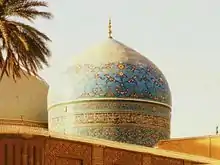| Part of a series on Islam Sufism |
|---|
 |
|
|
| Part of a series on Sunni Islam |
|---|
|
|
| Part of a series on Shia Islam |
| Twelver Shi'ism |
|---|
|
|
In Islam, ‘Irfan (Arabic/Persian/Urdu: عرفان; Turkish: İrfan), literally ‘knowledge, awareness, wisdom’, is gnosis.[1] Islamic mysticism can be considered as a vast range that engulfs theoretical and practical and conventional mysticism.
Sunni mysticism
According to the founder of the Qadiriyya Tariqa, Sayyid Abdul Qadir Gilani Irfan is described as the acknowledgement of God's unity. This acknowledgement is achieved by studying under Islamic scholars. One method how these scholars can help in gaining acknowledgement about God's unity is by giving more inside in the internal meaning of the practice of Islamic rituals, like the Salah. The reflection upon the practice of Islam with the knowledge of respected Islamic scholars (in concreto Awliya Allah) is described by the Sayyid as "nearness to God", manifested in acknowledgement of Allah (Irfan).[2]
Avicenna also says in one of his books in definition of mystic as: the one that doesn't allow himself physical pleasures and overlooks this carnal world's pleasures is called "ascetic". The one that observes saying prayers and fasting, etc. is called "worshiper". The one that prevents his conscious from paying attention to the others but God and directed it to the transcendent world to be enlightened by God's light is known as "mystic". However, sometimes two or all these designations can be applied to a single person.
Shi'ite mysticism
Ayatollah Al Sistani defines true Irfan as the practice of reciting prescribed duas taught by Twelve Imams, praying the Night Prayer, and seeking God's pleasure through Mustahab (recommended) actions.
Among the most famous modern Shia proponents of Irfan were Usuli theologians Muhammad Husayn Tabatabai, Ruhollah Khomeini, Mohammad-Taqi Bāhjat, Hassan Hassanzadeh Amoli, and Ali Tabatabaei.
